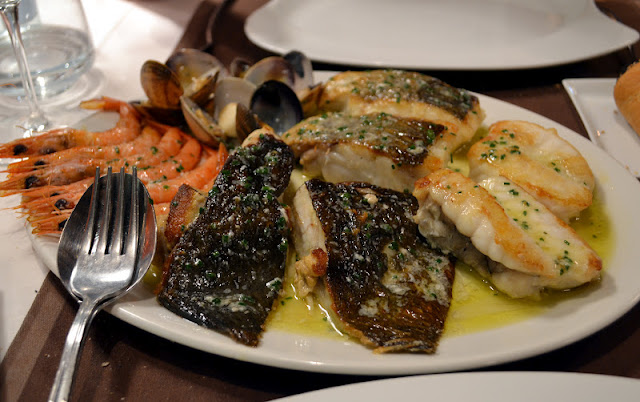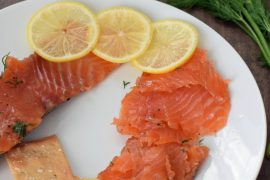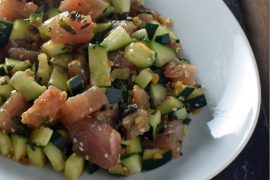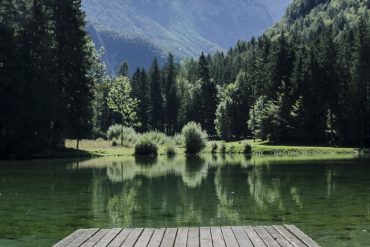 |
| Cod Pintxo at Gran Sol; Mixed Seafood Grill at Abarka Jatetxea; Smoked Salmon Salad at La Ruelle; Axoa at Aintzina |
This is the second installment of our Beyond the Five Boroughs series on Northern Spain and the first of three on the Basque Country. The next post will cover pintxos in San Sebastian, and the third will be a review of the renowned Restaurante Arzak. The first post was on Barcelona.
I knew I had fallen in love with the Basque Country when, a few hours off the plane from Barcelona, I found myself standing at a wooden table over a small but elaborately prepared pintxo featuring grilled shrimp. The shrimp were grilled to perfection and piled on top of juicy roasted tomato and a smooth white puree of cabracho, a funny-looking fish. The whole thing was sitting in a pink seafood broth with a drizzle of bright green herb oil and topped with trout caviar and vinaigrette foam. It was perfect. The shrimp had just the right texture and the cabracho had just enough body to stand up to the flavorful sauce.
 |
| Grilled Shrimp Pintxo at Gran Sol |
I was at Gran Sol, a well-regarded pintxos bar in the quaint seaside town of Hondarriba. Pintxos (pronounced “PEEN-chohs”) are small plates or finger foods, sometimes simple and sometimes intricate, that are traditionally served on little toasts and speared through with a toothpick. The name “pintxo” derives from the Spanish word “pincho” (a “spike”, or a “skewer”), which refers to the toothpick holding the whole thing together. Traditionally, pintxos bars are self-serve; you grab a plate and go to town, grabbing whatever looks good to you in the moment. Some modern pintxos, like my shrimp at Gran Sol, are prepared to order and dispense with the toothpick.
My wife and I had come to Basque Country to enjoy its beautiful beaches and dynamic culture, and also to sample what is reputed to be some of the best food in the world. From elaborate pintxos in Hondarribia and San Sebastian, to French Basque specialties across the border, we were not disappointed.
Hondarribia
.jpg) |
| Parillada de Pescados at Abarka Jatetxea in Hondarribia |
Sitting right on the French border, the quaint town of Hondarribia is decorated with colorful sailboats, serene beaches and a walled old town with cobblestone streets. A narrow stretch of water separates it from Hendaye, France, which is accessible by a short ferry ride. Although it may seem like a border town, Hondarribia is actually in the center of Basque Country, which spans parts of Spain and France. Happy locals and Basque tourists speaking Spanish and French, as well as the Basque language, stroll the scenic waterfront promenade.
 |
| Gran Sol |
A few blocks from the promenade, on the tree-lined San Pedro Street, we were enjoying modern pintxos at Gran Sol. The place is unassuming, with a nondescript bar and a few round wooden tables inside and wooden barrels serving as cocktail tables outside. But the food is something else. Following our grilled shrimp dish was a pintxo of cod fillet slices with pimentón and sauteed onions sitting on creamy potatoes and topped with frizzled onions. A fantastic mixture of creamy, smokey and crisp. The addition of a few toothpick-laden snacks from the bar completed a satisfying an inexpensive meal for two.
 |
| Our bartender pouring Txakoli using proper form |
Pintxos are meant to be washed down with txakoli (pronounced “chah-ko-LEE”), a lightly sparkling dry white wine produced and served all over the Basque country. To be served properly, txakoli must be poured from a height so that the wine aerates as it falls and splashes against the glass below. Of all those who served us txakoli in the Basque country, which were many, our bartender at Gran Sol had the most perfect form: bottle over the head and perfectly horizontal, left arm fully extended, eyes gazing downward, glass held below the waist.
Dinner that night was at Abarka Jatetxea, an elegant place in a traditional Basque townhouse with a lovely covered patio. Following my strategy of ordering food in seaside towns, I asked for the local fish soup and was rewarded with a thick broth similar to bouillabaisse with chunks of various kinds of fish in it. A lighter appetizer also arrived consisting of thick cubes of lightly smoked salmon neatly assembled among halves of grape tomatoes, the composition tied together with a single thin shaving of asparagus, with a simple lettuce salad on the side.
 |
| Torrijas at Abarka Jatetxea |
But highlight of the meal was the parrillada de pescados, which I roughly translate as “mixed grill of fish.” It came with generous portions of three kinds of fish, head-on shrimp and delicate clams in the shell. The fish were grilled to perfection and topped with little more than extra virgin olive oil, parsley and perhaps a little white wine. This was simple seaside fare at its best, the fish so fresh that little had to be done to bring out its full flavor. We barely saved room for a dessert of torrijas – the Spanish cross between french toast and bread pudding – which was served with caramel sauce and excellent homemade ice cream.
La Côte Basque: Saint Jean-de-Luz and Espelette
 |
| Axoa with potatoes at Aintzina |
The next day we rented a car for a day trip through la Côte Basque, France’s Basque coast. Our first stop was the extraordinary beach town of Saint Jean-de-Luz, perhaps France’s answer to San Sebastian. It has a stunning crescent-shaped beach with a raised promenade filled with fresh ice cream stands, the occasional clothing or souvenir shop, and happy Basques and French vacationers (and the occasional British family) enjoying their day in the sun. If I could have had more time in one place on our trip, it would have been in Saint Jean-de-Luz. May the rest of America never discover it.
 |
| Moules Basquaise at La Ruelle in Saint Jean-de-Luz |
Feeling un peu faim, we stopped for lunch at La Ruelle, an affordable spot located steps from the beach and offering outdoor tables on a narrow, bustling pedestrian street. On that warm summer afternoon by the beach, a bowl of moules basquaise was exactly what I had in mind: like all things “basquaise,” the perfectly steamed mussels were topped with a melange of tomato, eggplant, red peppers, onions, and garlic. The mussels were cooked perfectly, not at all chewy, and served as a vehicle for enjoying the basquaise topping. La Ruelle also put together a terrific smoked salmon salad, with thinly sliced salmon that was fairly heavily smoked and draped over simple lettuces tossed in a mustardy vinaigrette.
 |
| A picnic of Basque cheese and piment d’Espelette jam |
In the early evening we drove through the mountains to the quaint town of Espelette in search of their renowned eponymous peppers, the piments d’Espelette, with their mildly spicy flavor similar to hot paprika. The peppers were everywhere: dried and hanging from balconies, stuffed into jars, mixed into mustards, purees and jams, crumbled into powder, baked into savory cookies, and emblazoned on tee shirts, coffee cups, and oven mitts. My wife had to restrain me in the specialty food stores, but before she could stop me I did make out with some jars of jam, puree and mustard and a few shakers of powder. In return, she extracted a promise of a picnic lunch of Basque cheese, piment d’Espelette jam and fresh baguettes by the lakes of Covadonga in Asturias (post forthcoming).
We stopped for dinner at Aintzina, which we chose because it was overflowing with people. Unfortunately, that meant there were no tables left out on the cobblestone street or out back in their peaceful garden. Settling at a table in the comfortable interieur, we began with two glasses of the house rosé (combined €2.45), poured from a tap set in a barrel in the wall.
 |
| Gâteau Basque |
Naturally, we wanted to try the peppers as soon as possible, so we started with simple salad featuring goat cheese topped with Espelette pepper jam. The jam gave the cheese a beautiful sweet and mildly spicy kick, almost helping us ignore the gratuitous mound of ham that served as a reminder that we were in France. The star of the show, however, was the Axoa (“ah-CHOH-ah”), a traditional ground veal dish from Espelette that resembles a cross between sausage and peppers and Texas-style beanless chili, topped with copious Espelette pepper. It was served with spectacular cubed potatoes sauteed in garlic and parsley, a promised accompaniment with any entree, which my wife (a French food skeptic) still refers to as the best potatoes she’s ever had. The meal ended with a traditional gâteau basque, a crumbly cake made with almond flour and filled with custard.
We returned to Hondarribia satisfied, and as we drove through the French Basque countryside by moonlight it occurred to us that the next day we were headed to the capital of Basque cuisine, San Sebastian.
Continue to Basque Country Part 2: Pintxos in San Sebastian.
View Basque Country: Hondarribia and La Côte Basque in a larger map
Gran Sol: San Pedro, 65. 20280 Hondarribia. +34 94 364 27 01.
http://bargransol.com/
Abarka Jatetxea: Baserritar Etorbidea, 36. 20280 Hondarribia. +34 943 64 19 91.
http://www.restabarka.com/
La Ruelle: 19 Rue de la République, 64500 Saint-Jean-de-Luz. +33 05 59 26 37 80.
Aintzina: 440 Karrika Nagusia, 64250 Espelette. +33 05 59 93 91 62.
Visit Spain and the Basque Country:



